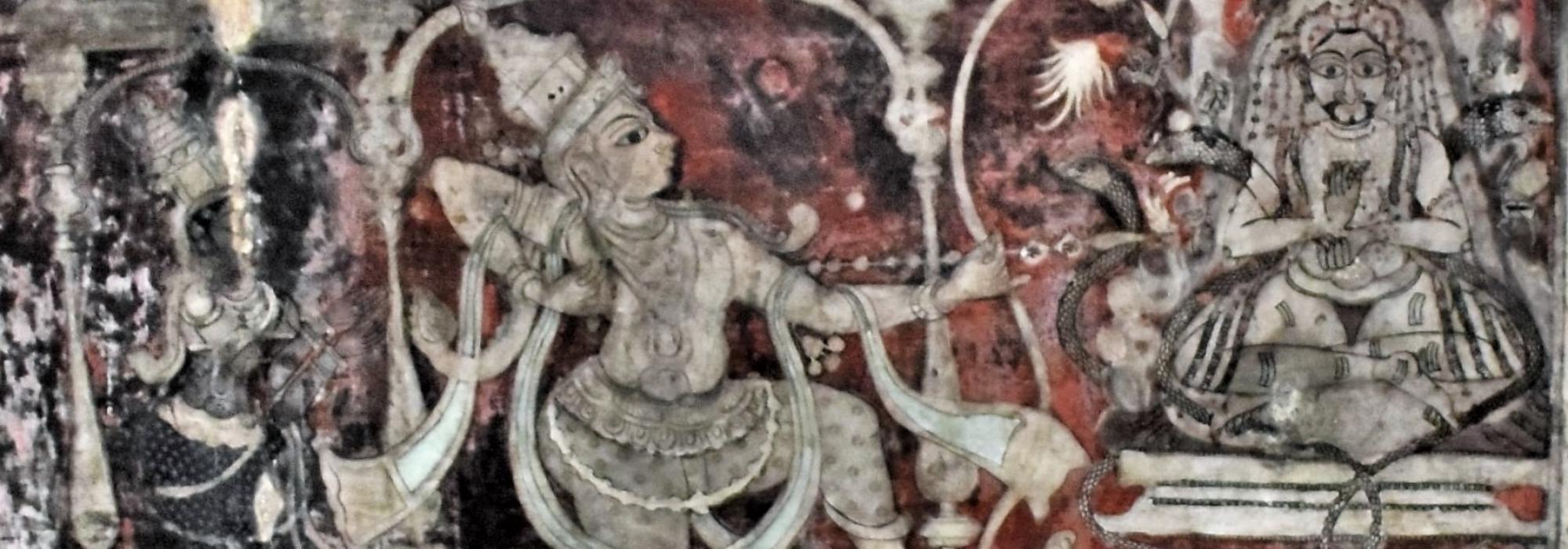continued from the previous part...
Though Manmatha avoided Śiva ’s glance, he has placed himself in a convenient position, such that Śiva was visible to him. He observes Śiva, whose costumes (āhārya), bodily features (āṅgika) and mental frame-work (sāttvika) are absolutely orthogonal to his own. [The next set of verses have been beautiful treated by Shatavadhani Dr. R Ganesh ins his talks and his article on the cinematography in Kumārasambhava].
सदेवदारुद्रुमवेदिकायां शार्दूलचर्मव्यवधानवत्याम् ।
आसीनमासन्नशरीरपातस्त्रियम्बकं संयमिनं ददर्श ।। 3.44 ।।
Śiva was seated under the Devadāru tree, clad in the skin of a (dead) tiger. Manmatha, whose body was soon to be gone, saw the three-eyed Śiva, lord of his own self, seated in deep meditation.
Śiva’s āhārya, which was only given a passing reference in the first sarga, gets a wholesome treatment here, as it is being described through Manmatha’s eyes. He is trying to perceive his ‘prey’ in its wholesomeness, just as an archer would make sure to know all the properties of his target.
पर्यङ्कबन्धस्थिरपूर्वकायमृज्वायतं संनमितोभयांसम् ।
उत्तानपाणिद्वयसंनिवेशात्प्रफुल्लराजीवमिवाङ्कमध्ये ।। 3.45 ।।
The static āṅgika of Śiva is very well captured by the verse – the fore part of his body is upright, his shoulders a little bent and his palms facing upwards, like lotus in its bloom. The non-dynamic body, after all, reflects a serene mind – motionless and transparent. Śiva is in a state of equanimity both in the internal and the external dimensions.
भुजङ्गमोन्नद्धजटाकलापं कर्णावसक्तद्विगुणाक्षसूत्रम् ।
कण्ठप्रभासङ्गविशेषनीलां कृष्णत्वचं ग्रन्थिमतीं दधानम् ।। 3.46 ।।
The complexion of Śiva ’s neck is dark – due to the poison he had swallowed in the past – he had even assimilated Death, which the rest of the world was scared to even face. To add to these black features, his long, unkempt hair is tied up together by the hair-band of a snake and his ears are decked with two strings of rudrākṣas, dark in colour - he also has the black buck’s skin tied around his body and knotted it. Manmatha (and his aide Vasanta), who is colourful in every aspect – looks at his ‘dark’ target. A grey picture of Śiva, painted through the colourful eyes of Manmatha, indeed.
Each element of Śiva ’s āhārya is of a different texture, and a different shade of darkness! Connoisseurs will readily be able to see the contrasting features of Śiva’s and Manmatha’s mental state, āṅgika and āhārya
किंचित्प्रकाशस्तिमितोग्रतारैर्भ्रूविक्रियायां विरतप्रसङ्गैः ।
नेत्रैरविस्पन्दितपक्ष्ममालैर्लक्ष्यीकृतघ्राणमधोमयूखैः ।। 3.47 ।।
Śiva, seated in meditation, looked at the tip of his nose with his eyes (three in number - netraiḥ) and his fierce pupils were motionless and radiated brilliance. His eyebrows were hardly knitted. Though he appears to be dark all around, it is only an envelope for the bright rays that emit from his eyes and are directed towards the tip of the nose. This is the posture of a yogi, indeed!
अवृष्टिसंरम्भमिवाम्बुवाहमपामिवाधारमनुत्तरङ्गम् ।
अन्तश्चराणां मरुतां निरोधान्निवातनिष्कम्पमिव प्रदीपम् ।। 3.48 ।।
Śiva had brought all the five kośas to a stall – Annamaya- kośa wasdescribed so far and now, it is the prāṇamaya-kośa – he had his breath (and other vital airs - pañca-prāṇa under control) Just as a dark cloud – full of sattva (ambuvāha) doesn’t burst into rain in the absence of wind, just as there are no ripples on the surface of a water body due to its internal calm and just as the lamp is steady in a place free of wind, Śiva too sat motion-less. The three imageries used here speak volumes. Śiva has all the sattva within him, but is not noisy (like Vasanta or Manmatha); there are no ripples on his person through there is brilliance of prakāśānanda emerging forth.
कपालनेत्रान्तरलब्धमार्गैर्ज्योतिःप्ररोहैरुदितैः शिरस्तः ।
मृणालसूत्राधिकसौकुमार्यां बालस्य लक्ष्मीं ग्लपयन्तमिन्दोः ।। 3.49 ।।
There were rays of light emerging out from his head (from the brahmarandhra), through the eyes of the kapāla on his head. As discussed in the previous segments, the poet Kālidāsa makes sure to let his readers understand the intensity, texture and the other properties of all elements he describes. To help us understand if the light that manifested from Śiva’s head is sharp and piercing or soft and cool, he gives the following imagery – ‘it (the external manifestation of prakāśānanda) put to shame the grace of the young moon, which is softer than that of lotus-fibres.
मनो नवद्वारनिषिद्धवृत्ति हृदि व्यवस्थाप्य समाधिवश्यम् ।
यमक्षरं क्षेत्रविदो विदुस्तमात्मानमात्मन्यवलोकयन्तम् ।। 3.50 ।।
Śiva had put all the vṛttis of his mind under restful peace in his heart and all the ‘nine doors’ of sense and action of the body were completely sealed under his control. He looked at Himself within Himself – आत्मानमात्मन्यवलोकयन्तम् [1]
स्मरस्तथाभूतमयुग्मनेत्रं पश्यन्नदूरान्मनसाप्यधृष्यम् ।
नालक्षयत्साध्वससन्नहस्तः स्त्रस्तं शरं चापमपि स्वहस्तात् ।। 3.51 ।।
As Smara, the one born out of the mind, looked at Śiva – the odd-eyed one - who was in such deep samādhi, he did not even realise that his hand drooped in fear and his bow and arrow dropped off from his hand – he was so lost in the sight of Śiva that he lost consciousness of his own body (āṅgika). The poet adds a detail here – Śiva was someone who could not even be assailed by thoughts, let alone through the physical medium.
To be continued...
Footnotes
[1] The experiencer, the experienced object and the experience all being One - the ātmā. The poet is suggesting the dissolution of tripuṭi here – a feature that is extremely difficult to be depicted through nāṭya or nṛtya.















































